
3 hostages rescued in Colombia return to US
7/3/2008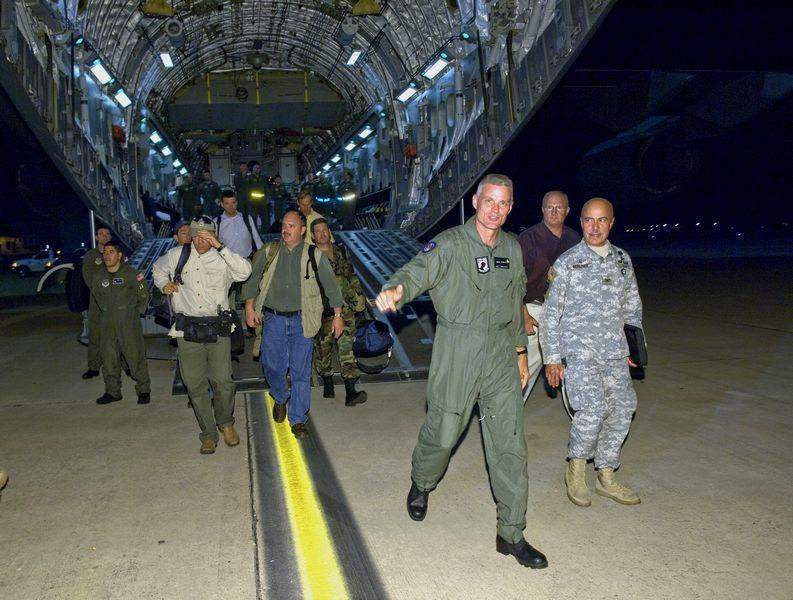
In this image provided by the US Air Force former American hostage Keith Stansell, third from right, steps off the ramp of a C-17 Globemaster III onto U.S. soil at Lackland Air Force Base, Texas on Wednesday.

In this image provided by the US Air Force former American hostage Keith Stansell, third from right, steps off the ramp of a C-17 Globemaster III onto U.S. soil at Lackland Air Force Base, Texas on Wednesday.
LACKLAND AIR FORCE BASE, Texas - With little fanfare, three American hostages rescued from leftist guerillas in Colombia returned safely to the United States, more than five years after their plane went down in rebel-held jungle.
The men didn't wave to reporters or bend down to kiss the ground upon their return late Wednesday. They simply boarded waiting helicopters, which took them to a hospital where they were expected to reunite with their families.
The U.S. military contractors Marc Gonsalves, Thomas Howes and Keith Stansell had been held by the Revolutionary Armed Forces of Colombia since their drug-surveillance plane went down in the jungle in February 2003. Nowhere in the world have American hostages currently in captivity been held longer, according to the U.S. Embassy in Bogota.
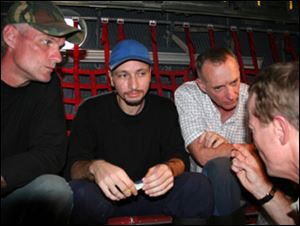
In this image released by the U.S. embassy in Colombia, U.S. contractors Keith Stansell, left, Marc Gonsalves, center, and Thomas Howes sit in an aircraft in an unknown location in Colombia after being rescued by Colombia's military from the Revolutionary Armed Forces of Colombia, or FARC on Wednesday.
The three were rescued when Colombian spies tricked leftist rebels into handing them over along with kidnapped presidential candidate Ingrid Betancourt. She was also freed Wednesday, as were 11 Colombian police and soldiers.
A plane carrying the Americans landed at Lackland Air Force Base shortly after 11 p.m. All appeared well as they exited the Air Force C-17. The men were then flown by choppers to Brooke Army Medical Center in San Antonio, where they were expected to undergo tests.
Long before their rescue, it seemed like any public efforts to rescue the hostages had disappeared.
While France exhorted the world to care about the plight of Betancourt, and even sent a humanitarian mission in a failed rescue attempt this year, the U.S. government remained nearly silent about efforts to free the Americans, employees of a Northrop Grumman Corp. subsidiary that has supported Colombia's fight against drugs and rebels.
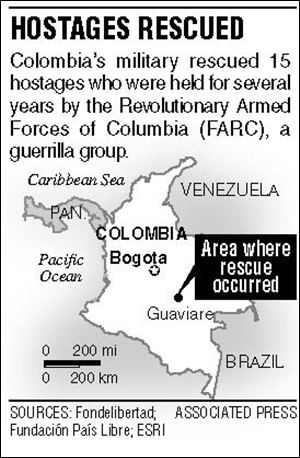
Howes is a native of Chatham, Mass.; Gonsalves' father lives in Hebron, Conn.; and Stansell's family lives in Miami.
Their families complained publicly about what seemed to be the U.S. government's failure to act.
"We didn't know what the heck was going on," Gonsalves' father, George, told reporters. "I'm getting information from you guys."
The Americans' fate seemed particularly grim after "proof-of-life" images released in November showed them appearing haggard, even haunted, against a deep jungle background.
The contractors and Betancourt were among a group of rebel-designated "political prisoners" whom the FARC planned to release only in exchange for hundreds of imprisoned rebels. But every attempt at talking about a prisoner swap seemed to go nowhere.
Behind the scenes, however, Colombia's armed forces were closing in on the rebels, with the help of billions of dollars in U.S. military support.
The U.S. and Colombian governments learned the hostages' location "any number of times" and planned several rescue missions during their five years in captivity, but the difficulty of extracting them alive had prevented the missions from being carried out, according to a U.S. government official in Washington who spoke on condition of anonymity because of the sensitivity of intelligence matters.
Last month, Colombian Defense Minister Juan Manuel Santos said soldiers had spotted the three men in the southern jungles, but they disappeared into the forest before the troops could attempt a rescue.
After the men were freed, U.S. Ambassador William Brownfield said U.S. and Colombian forces cooperated closely on the rescue mission, including sharing intelligence, equipment, training advice and operational experience.
The Americans appeared healthy in a video shown on Colombian television, though Brownfield, who met with them at a Colombian military base, said two of the three were suffering from the jungle malady leishmaniasis and "looking forward to modern medical treatment."
George Gonsalves was mowing his yard when an excited neighbor relayed the news he had seen on television.
"I didn't know how to stop my lawnmower," he said. "I was shocked. I couldn't believe it."
"We're still teary-eyed and not quite have our wits about us," said Stansell's stepmother, Lynne.
And Howes' niece, Amanda Howes, said the rescue "redefines the word miracle."
Congratulations poured in to Colombian President Alvaro Uribe from President Bush and both presidential candidates. Republican Sen. John McCain said Uribe had told him in advance of the rescue plans while he was campaigning in Colombia. "It's a very high-risk operation," he said. "I congratulate President Uribe, the military and the nation of Colombia."
Democrat Barack Obama also sent his congratulations, saying he supports "Colombia's steady strategy of making no concessions to the FARC, and its targeted use of intelligence, military, law enforcement, diplomatic and political power to achieve important victories against terrorism."
Gonsalves' father, who later got a phone call from the FBI confirming his son was free, expected an emotional family reunion, especially for his son's three children, now teenagers. "Think about your children if they don't see you for a week a weekend or a month," he said. "It's five years pulled out of your life."
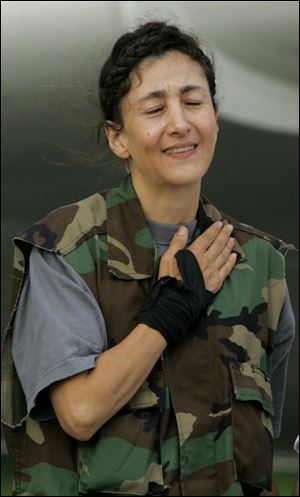
Former hostage Ingrid Betancourt gestures as she arrives to a military base in Bogota after being rescued from six years of captivity on Wednesday.
From earlier editions of toledoblade.com.
BOGOTA, Colombia - Colombian soldiers tricked leftist guerrillas in a jungle camp into freeing 15 hostages, including a former Colombian presidential candidate and three U.S. military contractors, officials said yesterday.
Ingrid Betancourt, the former presidential candidate, was seized on the campaign trail in February, 2002. She appeared surprisingly healthy as she strode down the stairs of a military plane and held her mother in a long embrace.
She said she still aspires to the presidency.
"God, this is a miracle," Ms. Betancourt said.
Eleven Colombian police and soldiers were also freed in the rescue, the most serious blow ever dealt to the 44-year-old Revolutionary Armed Forces of Colombia.
The Americans - Marc Gonsalves, Thomas Howes, and Keith Stansell - were flown directly to the United States to reunite with their families and will undergo tests and treatment at Brooke Army Medical Center in San Antonio.
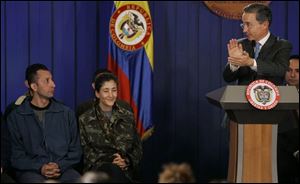
Colombia's President Alvaro Uribe, right, applauds as he looks toward former hostage Ingrid Betancourt, second left, during an event at the presidential palace in Bogota, Wednesday.
They had been the longest-held American hostages in the world, according to the U.S. Embassy in Bogota.
The three Americans were taken prisoner when their single-engine plane crashed in Caqueta province in February, 2003.
"This was an unprecedented operation," Colombian Defense Minister Juan Manuel Santos said. "It will go down in history for its audaciousness and effectiveness."
Mr. Santos said military intelligence agents infiltrated the guerrilla ranks and led the local commander in charge of the hostages, alias Cesar, to believe they were going to take them to Alfonso Cano, the rebels' new leader.
The hostages, who had been divided in three groups, were taken to a rendezvous where two helicopters piloted by disguised Colombian military agents were waiting.
As the hostages and two FARC guards boarded the helicopter, the guards were either forced or persuaded to give up the hos-tages without a shot.
The hostages were flown from the rescue point near San Jose del Guaviare to Colombia's largest air force base near Melgar, and then on to Bogota, where they were met by their families and dignitaries.
Television images showed a joyous Ms. Betancourt.
"To all of you who were with me through your prayers, who thought about me, who had me in your hearts if only for a minute," she said from Bogota. "Thank you."
But her biggest praise was for her rescuers. "Thank you to the army for its impeccable operation. The operation was perfect," she said.
No injuries were reported in the rescue and two top FARC commanders were arrested, officials said.
In Washington, Gordon Johndroe, the spokesman for the White House National Security Council, said President Bush called Colombia President Alvaro Uribe to praise the rescue.
"The two presidents spoke about the good news of the release of the hostages," Mr. Johndroe said. "President Bush congratulated President Uribe, telling him he is a strong leader."
FARC, which has been waging war for more than four decades, still has more than 700 hostages, including 400 military and police.
Ms. Betancourt, 46, was kidnapped in 2002 while campaigning for president after peace talks between the government and the rebels broke down.
She became the highest-profile prisoner and an international symbol of the incarcerated, in part because of her dual citizenship with France.
At first she said she thought the pilots were from a relief group. Then she saw their Che Guevara shirts and assumed they were rebels.
Only when they were airborne did she notice that Cesar, who had treated her so cruelly for so many years, was naked and blindfolded on the floor.
"The chief of the operation said, 'We're the national army. You're free,'" she said. "The helicopter almost fell from the sky because we were jumping up and down, yelling, crying, hugging one another. We couldn't believe it."
"We wanted to have it happen as it did today," armed forces chief Gen. Freddy Padilla said. "Without a single shot. Without anyone wounded. Absolutely safe and sound, without a scratch."
Though officials said everyone directly involved in the rescue were Colombians, U.S. Ambassador William Brownfield said there was "close cooperation" from Americans. The other rebel captors retreated into the jungle, Mr. Santos said, and the army let them escape "in hopes that they will free the rest of the hostages."